
-
 Afrikaans
Afrikaans -
 Albanian
Albanian -
 Amharic
Amharic -
 Arabic
Arabic -
 Armenian
Armenian -
 Azerbaijani
Azerbaijani -
 Basque
Basque -
 Belarusian
Belarusian -
 Bengali
Bengali -
 Bosnian
Bosnian -
 Bulgarian
Bulgarian -
 Catalan
Catalan -
 Cebuano
Cebuano -
 China
China -
 China (Taiwan)
China (Taiwan) -
 Corsican
Corsican -
 Croatian
Croatian -
 Czech
Czech -
 Danish
Danish -
 Dutch
Dutch -
 English
English -
 Esperanto
Esperanto -
 Estonian
Estonian -
 Finnish
Finnish -
 French
French -
 Frisian
Frisian -
 Galician
Galician -
 Georgian
Georgian -
 German
German -
 Greek
Greek -
 Gujarati
Gujarati -
 Haitian Creole
Haitian Creole -
 hausa
hausa -
 hawaiian
hawaiian -
 Hebrew
Hebrew -
 Hindi
Hindi -
 Miao
Miao -
 Hungarian
Hungarian -
 Icelandic
Icelandic -
 igbo
igbo -
 Indonesian
Indonesian -
 irish
irish -
 Italian
Italian -
 Japanese
Japanese -
 Javanese
Javanese -
 Kannada
Kannada -
 kazakh
kazakh -
 Khmer
Khmer -
 Rwandese
Rwandese -
 Korean
Korean -
 Kurdish
Kurdish -
 Kyrgyz
Kyrgyz -
 Lao
Lao -
 Latin
Latin -
 Latvian
Latvian -
 Lithuanian
Lithuanian -
 Luxembourgish
Luxembourgish -
 Macedonian
Macedonian -
 Malgashi
Malgashi -
 Malay
Malay -
 Malayalam
Malayalam -
 Maltese
Maltese -
 Maori
Maori -
 Marathi
Marathi -
 Mongolian
Mongolian -
 Myanmar
Myanmar -
 Nepali
Nepali -
 Norwegian
Norwegian -
 Norwegian
Norwegian -
 Occitan
Occitan -
 Pashto
Pashto -
 Persian
Persian -
 Polish
Polish -
 Portuguese
Portuguese -
 Punjabi
Punjabi -
 Romanian
Romanian -
 Russian
Russian -
 Samoan
Samoan -
 Scottish Gaelic
Scottish Gaelic -
 Serbian
Serbian -
 Sesotho
Sesotho -
 Shona
Shona -
 Sindhi
Sindhi -
 Sinhala
Sinhala -
 Slovak
Slovak -
 Slovenian
Slovenian -
 Somali
Somali -
 Spanish
Spanish -
 Sundanese
Sundanese -
 Swahili
Swahili -
 Swedish
Swedish -
 Tagalog
Tagalog -
 Tajik
Tajik -
 Tamil
Tamil -
 Tatar
Tatar -
 Telugu
Telugu -
 Thai
Thai -
 Turkish
Turkish -
 Turkmen
Turkmen -
 Ukrainian
Ukrainian -
 Urdu
Urdu -
 Uighur
Uighur -
 Uzbek
Uzbek -
 Vietnamese
Vietnamese -
 Welsh
Welsh -
 Bantu
Bantu -
 Yiddish
Yiddish -
 Yoruba
Yoruba -
 Zulu
Zulu
the importance of frp launder in modern water treatment
The Importance of FRP Launder in Modern Water Treatment
In the realm of modern water treatment, the role of Fiber Reinforced Plastic (FRP) launder systems has grown increasingly significant. As societies grapple with the challenges of clean water provision and environmental sustainability, FRP launders have emerged as a vital component in various water treatment processes. This article explores the importance of FRP launders, primarily focusing on their advantages, applications, and contribution to improving water quality.
FRP launders are channels or troughs made from composite materials, primarily consisting of fiberglass and resin. These materials offer exceptional durability and corrosion resistance compared to traditional options like concrete or metal. This attribute makes FRP launders particularly valuable in water treatment facilities that must manage the corrosive nature of certain chemicals and process byproducts. The longevity of FRP systems not only reduces maintenance costs but also minimizes the need for frequent replacements, thereby promoting sustainable practices.
One of the most critical applications of FRP launders is in the sedimentation and clarifier processes. These systems are responsible for the removal of suspended solids from water through gravity separation. FRP launders play a crucial role in collecting and channeling the clarified water from these units, ensuring efficient flow and minimal turbulence that could disturb settled solids. The lightweight nature of FRP allows for easy installation and retrofitting in existing plants, making it a preferred choice for modernizing facilities aiming for better operational efficiency.
the importance of frp launder in modern water treatment

Moreover, the design flexibility associated with FRP launders enables engineers to create custom configurations tailored to specific site requirements. This adaptability can enhance water treatment efficiency by optimizing flow dynamics, which is essential for achieving desired treatment outcomes. For instance, adjustable weir heights in FRP launders can facilitate precise control over water levels, improving the separation processes in clarifiers.
Another significant advantage of FRP launders is their resistance to fouling and scaling. In water treatment operations, scaling can lead to reduced flow rates and increased energy consumption. The smooth surface of FRP minimizes the adherence of debris and biological growth, which helps maintain consistent flow rates and lowers operational costs. This property is particularly crucial in high-volume treatment plants where efficiency is paramount.
Additionally, the lightweight nature of FRP allows for reduced construction costs. Since these materials are easier to handle and transport, water treatment facilities can benefit from lower labor and installation costs. The improved ergonomics of handling FRP also contribute to safer working conditions for maintenance staff, reducing the risk of injury associated with heavier materials.
In conclusion, FRP launders are essential in modern water treatment systems due to their durability, flexibility, and ability to enhance operational efficiency. As water scarcity and quality issues become more pressing worldwide, the adoption of advanced materials like FRP will be critical. Their role in improving water treatment processes not only contributes to better water quality but also supports sustainable practices that are essential for future generations. Embracing such innovations will ultimately result in cleaner water and a healthier environment.









